
|
Now it is 7.2 mag (May 11, Con Stoitsis). It will pass close to the earth from spring to summer, and it is expected to brighten up to 6 mag. In the Southern Hemisphere, it keeps observable in excellent condition after this. In the Northern Hemisphere, it locates low in the south.
Date(TT) R.A. (2000) Decl. Delta r Elong. m1 Best Time(A, h)
May 14 23 18.83 -6 4.4 1.426 1.360 65 7.1 5:19 (239, 44)
May 21 23 9.99 -9 20.5 1.243 1.390 75 6.9 5:23 (231, 54)
|

|
It passed only 0.036 a.u. from the earth on Mar. 21-22, and brightened up to 3.9 mag (Mar. 21, Thomas Lehmann). It kept brightening even after the perihelion passage. It is very bright as 7.7 mag still now (May 6, Marco Goiato). It keeps observable in excellent condition for a while after this both in the Northern Hemisphere and Southern Hemisphere. It may fade out very rapidly.
Date(TT) R.A. (2000) Decl. Delta r Elong. m1 Best Time(A, h)
May 14 17 3.54 8 54.6 0.326 1.286 143 8.6 1:37 (180, 46)
May 21 16 55.98 8 21.5 0.376 1.344 147 9.3 1:02 (180, 47)
|

|
Now it is so bright as 10.0 mag (May 4, Seiichi Yoshida). It will be fading slowly after this. It is observable in excellent condition in the Northern Hemisphere. It is observable in the evening sky also in the Southern Hemisphere until August.
Date(TT) R.A. (2000) Decl. Delta r Elong. m1 Best Time(A, h)
May 14 10 58.19 42 55.9 2.511 2.762 93 10.5 19:28 (180, 12)
May 21 10 58.54 39 41.5 2.637 2.812 89 10.7 19:01 (180, 16)
|

|
Now it is 11.2 mag (May 10, Thomas Lehmann). It keeps 11 mag until summer. In the Northern Hemisphere, it will be getting lower after this, and will be unobservable in June. It locates somewhat low in the Southern Hemisphere, but it keeps observable until August.
Date(TT) R.A. (2000) Decl. Delta r Elong. m1 Best Time(A, h)
May 14 7 25.89 22 6.6 2.065 1.725 56 11.8 18:33 (141, 22)
May 21 7 43.72 21 36.5 2.088 1.700 53 11.8 18:29 (140, 22)
|

|
Now it is 13.6 mag (May 7, Jakub Cerny). Brightening very rapidly, but it is fainter than this ephemeris. It is expected to be observable at 11 mag in good condition until summer.
Date(TT) R.A. (2000) Decl. Delta r Elong. m1 Best Time(A, h)
May 14 11 41.59 16 9.7 1.037 1.729 115 12.0 20:12 (180, 39)
May 21 11 44.93 14 26.0 1.062 1.700 110 11.9 19:48 (180, 41)
|
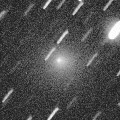
|
Now it is very bright as 11.5 mag (May 8, Jakub Cerny). In the Northern Hemisphere, it is observable at 12 mag in excellent condition until June. It locates very low in the Southern Hemisphere.
Date(TT) R.A. (2000) Decl. Delta r Elong. m1 Best Time(A, h)
May 14 22 53.08 36 36.7 1.613 1.437 61 12.0 5:19 (206, 13)
May 21 22 33.83 40 36.0 1.481 1.469 69 12.0 5:23 (195, 12)
|

|
Now it is 12.2 mag (May 2, Seiichi Yoshida). It keeps 12-13 mag for a long time from 2015 autumn to 2016 summer. In the Northern Hemispehre, it keeps observable in good condition for a long time. It keeps unobservable until July in the Southern Hemisphere.
Date(TT) R.A. (2000) Decl. Delta r Elong. m1 Best Time(A, h)
May 14 18 2.16 72 12.8 2.645 2.755 85 12.3 2:35 (180,-17)
May 21 17 25.88 71 23.8 2.636 2.773 86 12.3 1:32 (180,-16)
|

|
Now it is 11.9 mag (May 4, Seiichi Yoshida). It brightened up to 6 mag from autumn to winter. Now it is fading. It is not observable after this in the Southern Hemisphere. It will be extremely low from May to June also in the Northern Hemisphere.
Date(TT) R.A. (2000) Decl. Delta r Elong. m1 Best Time(A, h)
May 14 5 0.86 46 48.5 3.686 2.909 34 12.5 18:33 (136,-16)
May 21 5 7.12 46 41.2 3.820 2.993 30 12.7 18:29 (135,-18)
|

|
It will brighten up to 11 mag from summer to autumn. It will appear in the morning sky in summer, but it keeps low for some time.
Date(TT) R.A. (2000) Decl. Delta r Elong. m1 Best Time(A, h)
May 14 1 42.93 19 40.1 2.603 1.728 23 13.6 5:19 (245, 1)
May 21 2 2.96 21 0.3 2.541 1.684 25 13.4 5:23 (242, 2)
|
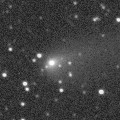
|
Now it is 13.1 mag (May 5, Chris Wyatt). It keeps 13 mag for a while. It is observable in excellent condition in the Southern Hemisphere. But it locates somewhat low in the Northern Hemisphere.
Date(TT) R.A. (2000) Decl. Delta r Elong. m1 Best Time(A, h)
May 14 15 40.76 -23 20.4 1.343 2.351 173 13.4 0:14 (180, 78)
May 21 15 35.06 -23 12.6 1.358 2.368 175 13.5 23:36 (180, 78)
|

|
It is observable in excellent condition in the Southern Hemisphere. Now it is faint as 17.1 mag (Apr. 27, Jean-Francois Soulier).
Date(TT) R.A. (2000) Decl. Delta r Elong. m1 Best Time(A, h)
May 14 19 55.81 -25 15.5 5.407 5.938 117 13.5 4:28 (180, 80)
May 21 19 55.31 -25 16.8 5.309 5.936 124 13.4 4:00 (180, 80)
|

|
It is not observable now. It will be observable at 16.5 mag in September in the Northern Hemisphere, or in November in the Southern Hemisphere.
Date(TT) R.A. (2000) Decl. Delta r Elong. m1 Best Time(A, h)
May 14 4 41.19 16 38.7 2.931 1.999 18 14.4 18:33 (109, -2)
May 21 4 58.38 17 17.3 2.945 1.992 15 14.3 18:29 (109, -3)
|
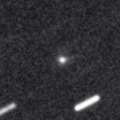
|
Now it is 15.4 mag (May 3, Sandor Szabo). It will be observable at 14 mag in good condition from spring to summer.
Date(TT) R.A. (2000) Decl. Delta r Elong. m1 Best Time(A, h)
May 14 20 51.90 -12 9.5 2.020 2.430 101 14.4 5:19 (183, 67)
May 21 20 58.62 -11 43.9 1.946 2.433 106 14.3 5:03 (180, 67)
|

|
Now it is 15.1 mag (Jan. 2, Ken-ichi Kadota). Distant object, but it keeps observable at 14-15 mag for a long time from 2015 to 2016.
Date(TT) R.A. (2000) Decl. Delta r Elong. m1 Best Time(A, h)
May 14 0 6.04 0 58.7 5.447 4.884 51 14.6 5:19 (243, 31)
May 21 0 11.91 1 20.1 5.362 4.883 56 14.5 5:23 (237, 36)
|
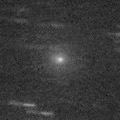
|
Now it is bright as 13.1 mag (May 4, Seiichi Yoshida). Although it was faint as 19.0 mag in January (Jan. 10, B. Lutkenhoner), it brightened rapidly in February. It keeps observable until May in the Northern Hemisphere, or until July in the Southern Hemisphere. But it keeps extremely low. The brightness differs in every apparition. It was not observed in the last apparition.
Date(TT) R.A. (2000) Decl. Delta r Elong. m1 Best Time(A, h)
May 14 6 2.18 17 18.9 1.964 1.316 37 14.6 18:33 (122, 13)
May 21 6 28.96 16 51.0 2.014 1.355 37 15.0 18:29 (122, 14)
|
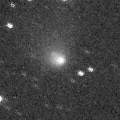
|
Now it is bright as 13.0 mag (May 6, Marco Goiato). It is observable at 14 mag in good condition from winter to summer.
Date(TT) R.A. (2000) Decl. Delta r Elong. m1 Best Time(A, h)
May 14 12 35.03 -15 39.6 1.474 2.338 139 14.7 21:04 (180, 71)
May 21 12 32.09 -16 24.1 1.531 2.338 132 14.8 20:34 (180, 72)
|
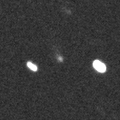
|
Now it is bright as 14.9 mag (May 4, Hidetaka Sato). It keeps 15 mag for a long time until 2016 autumn. In the Southern Hemisphere, it keeps observable for a long time. It will be unobservable after this in the Northern Hemisphere.
Date(TT) R.A. (2000) Decl. Delta r Elong. m1 Best Time(A, h)
May 14 4 48.07 -33 55.5 2.737 2.331 56 15.2 18:33 ( 66, 27)
May 21 5 0.32 -35 11.1 2.697 2.319 57 15.1 18:29 ( 63, 26)
|

|
Now it is 15.9 mag (May 4, Hidetaka Sato), brighter than originally predicted. It will brighten up to 14 mag in summer. In the Southern Hemisphere, it keeps observable until winter, but it locates somewhat low. In the Northern Hemisphere, it is not observable now. It will appear in the morning sky in July, then it will be observable in excellent condition.
Date(TT) R.A. (2000) Decl. Delta r Elong. m1 Best Time(A, h)
May 14 0 57.96 -11 59.5 2.022 1.529 47 15.6 5:19 (264, 29)
May 21 1 18.68 -9 26.5 1.979 1.503 47 15.3 5:23 (260, 30)
|

|
It will brighten up to 13 mag in summer. But it keeps unobservable for a long time. It will appear in the morning sky in December, when the comet will be fainter than 15 mag.
Date(TT) R.A. (2000) Decl. Delta r Elong. m1 Best Time(A, h)
May 14 4 34.84 17 36.2 2.986 2.040 16 15.5 18:33 (109, -4)
May 21 4 51.44 17 53.2 2.939 1.974 14 15.3 18:29 (108, -5)
|
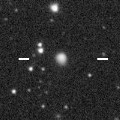
|
Now it is 15.7 mag (May 7, Thomas Lehmann). It is expected to brighten up to 7 mag in 2017 summer. In the Northern Hemisphere, it keeps observable in good condition until the highlight while the comet will be brightening. In the Southern Hemisphere, it is not observable until early 2017.
Date(TT) R.A. (2000) Decl. Delta r Elong. m1 Best Time(A, h)
May 14 7 15.39 58 5.9 5.279 4.812 57 15.4 18:33 (159, -9)
May 21 7 23.58 57 37.5 5.280 4.749 53 15.4 18:29 (157,-10)
|
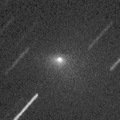
|
First return of an object discovered as an asteroid 2007 VA85 in 2007. It brightened very rapidly since mid February, and brightened up to 11.3 mag in spring (Mar. 5, Juan Jose Gonzalez). In the Northern Hemisphere, it locates extremely low in May, but it will be observable in the morning sky after June. However, it may fade out very rapidly and may be fainter than 18 mag. It keeps unobservable until September in the Southern Hemisphere.
Date(TT) R.A. (2000) Decl. Delta r Elong. m1 Best Time(A, h)
May 14 3 2.41 42 18.5 2.097 1.245 24 15.7 5:19 (235,-25)
May 21 2 58.94 43 50.6 2.118 1.289 26 16.9 5:23 (230,-20)
|
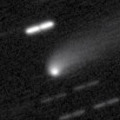
|
It brightened very rapidly in 2015 spring, and reached up to 13.8 mag (May 11, Sandor Szabo). It is bright as 14.4 mag still now (Apr. 8, Ken-ichi Kadota). It is observable in excellent condition in the Southern Hemisphere. But it locates somewhat low in the Northern Hemisphere.
Date(TT) R.A. (2000) Decl. Delta r Elong. m1 Best Time(A, h)
May 14 13 46.29 -28 9.8 3.249 4.190 155 16.2 22:16 (180, 83)
May 21 13 43.79 -27 39.0 3.312 4.218 149 16.3 21:46 (180, 83)
|

|
Now it is 16.1 mag (Apr. 5, Yasukazu Ikari). It keeps 16 mag until autumn. It keeps observable in good condition for a long time in the Northern Hemisphere. It keeps unobservable in the Southern Hemisphere.
Date(TT) R.A. (2000) Decl. Delta r Elong. m1 Best Time(A, h)
May 14 5 12.62 74 2.0 5.920 5.442 57 16.2 18:33 (163,-29)
May 21 5 33.11 74 17.7 5.962 5.458 55 16.2 18:29 (163,-29)
|

|
Now it is 16.0 mag (Apr. 14, H. Boussier). It will brighten up to 14 mag in 2017. In 2016, it keeps observable at 16 mag in good condition from winter to spring. The perihelion distance increases from 2.4 a.u. to 2.9 a.u. in this apparition, and the comet will not brighten as before.
Date(TT) R.A. (2000) Decl. Delta r Elong. m1 Best Time(A, h)
May 14 11 20.54 14 26.1 3.245 3.736 111 16.2 19:50 (180, 41)
May 21 11 21.04 14 0.3 3.324 3.720 105 16.3 19:23 (180, 41)
|

|
It brightened up to 3.7 mag and became a naked eye comet in mid January in 2015 (Jan. 13, Marek Biely). Now it is fading. It has already faded down to 16.1 mag (Mar. 26, Toshiyuki Takahashi). In the Northern Hemisphere, it keeps observable for a long time until the comet fades out. It locates somewhat low in the Southern Hemisphere.
Date(TT) R.A. (2000) Decl. Delta r Elong. m1 Best Time(A, h)
May 14 18 14.44 26 51.4 5.078 5.632 118 16.3 2:47 (180, 28)
May 21 18 9.57 27 0.1 5.090 5.694 122 16.4 2:15 (180, 28)
|
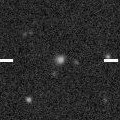
|
Now it is 16.8 mag (Apr. 12, K. Hills). The cometary activity is confirmed recently. It is expected to brighten up to 7 mag in 2017 spring. But it locates somewhat low at the high light.
Date(TT) R.A. (2000) Decl. Delta r Elong. m1 Best Time(A, h)
May 14 11 7.11 -0 43.9 4.236 4.746 114 16.4 19:37 (180, 56)
May 21 11 6.28 -0 27.9 4.270 4.677 107 16.4 19:09 (180, 56)
|
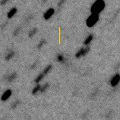
|
Now it is 16.7 mag (Apr. 15, Hiroshi Abe). It will brighten up to 16 mag from April to May. It is observable in excellent condition in the Southern Hemisphere. It locates somewhat low in the Northern Hemisphere.
Date(TT) R.A. (2000) Decl. Delta r Elong. m1 Best Time(A, h)
May 14 15 18.94 -34 43.6 1.047 2.037 163 16.5 23:47 (180, 90)
May 21 15 8.83 -36 20.4 1.062 2.046 161 16.6 23:10 ( 0, 88)
|
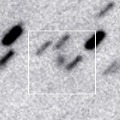
|
Now it is 16.5 mag (Apr. 5, Yasukazu Ikari). It keeps 16-17 mag for a long time from 2016 to 2019. It keeps locating near by the equator.
Date(TT) R.A. (2000) Decl. Delta r Elong. m1 Best Time(A, h)
May 14 8 5.41 4 2.5 10.227 9.928 70 16.5 18:33 (139, 42)
May 21 8 7.73 4 11.9 10.317 9.918 64 16.5 18:29 (133, 39)
|
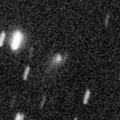
|
It brightened rapidly, and reached up to 15.5 mag (Feb. 11, Yasukazu Ikari). It will be fading after this. It has already faded down to 16.5 mag (Apr. 5, Yasukazu Ikari). It keeps observable until August when the comet becomes fainter than 18 mag in the Northern Hemisphere. It will be unobservable soon in the Southern Hemisphere.
Date(TT) R.A. (2000) Decl. Delta r Elong. m1 Best Time(A, h)
May 14 8 33.76 40 44.1 2.700 2.514 68 16.7 18:33 (163, 12)
May 21 8 43.08 41 38.1 2.786 2.515 64 16.7 18:29 (161, 10)
|

|
Now it is bright as 15.9 mag (Apr. 9, Hidetaka Sato). It keeps 16 mag for a long time from 2016 to 2017. In 2016, it is observable in excellent condition in the Southern Hemisphere, but it locates extremely low in the Northern Hemispehre.
Date(TT) R.A. (2000) Decl. Delta r Elong. m1 Best Time(A, h)
May 14 11 57.45 -37 51.8 2.998 3.743 131 16.8 20:27 ( 0, 87)
May 21 11 58.56 -36 3.4 3.012 3.710 126 16.8 20:01 ( 0, 89)
|
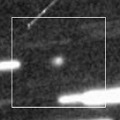
|
Now it is 17.3 mag (Apr. 20, Hidetaka Sato). It will be observable at 13 mag for a long time from 2017 to 2018. In 2016, it keeps observable at 16-17 mag in good condition until autumn.
Date(TT) R.A. (2000) Decl. Delta r Elong. m1 Best Time(A, h)
May 14 20 17.96 -13 9.1 6.150 6.559 109 16.9 4:50 (180, 68)
May 21 20 14.87 -12 48.5 5.994 6.515 116 16.8 4:20 (180, 68)
|

|
It brightened up to 15 mag from late 2014 to early 2016. Now it is fading slowly. In the Northern Hemisphere, it will be observable at 17 mag in autumn in good condition. It locates extremely low in the Southern Hemisphere.
Date(TT) R.A. (2000) Decl. Delta r Elong. m1 Best Time(A, h)
May 14 0 23.82 30 1.9 5.372 4.675 42 16.9 5:19 (225, 7)
May 21 0 24.03 31 11.5 5.322 4.701 47 16.9 5:23 (219, 11)
|
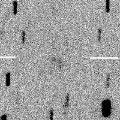
|
New comet. Now it is bright as 15.6 mag (May 6, Hidetaka Sato). It goes away from the earth rapidly, and it will be fainter than 18 mag in June.
Date(TT) R.A. (2000) Decl. Delta r Elong. m1 Best Time(A, h)
May 14 10 8.50 -12 36.2 0.993 1.583 104 17.0 18:39 (180, 67)
May 21 10 8.88 -3 56.4 1.164 1.612 95 17.4 18:29 (172, 58)
|
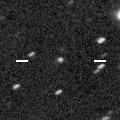
|
Now it is 17.4 mag (Apr. 14, ATLAS-HKO, Haleakala). It brightened rapidly, and became brighter than originally expected. It keeps 17 mag until 2017. It is observable in excellent condition in the Northern Hemisphere. It is not observable in the Southern Hemisphere.
Date(TT) R.A. (2000) Decl. Delta r Elong. m1 Best Time(A, h)
May 14 14 46.58 75 10.6 7.296 7.296 86 17.2 23:13 (180,-20)
May 21 14 26.23 74 45.9 7.327 7.293 84 17.2 22:26 (180,-20)
|

|
It brightened up to 13-14 mag from 2014 to 2015. Now it is fading. It will be observable at 17 mag in 2016.
Date(TT) R.A. (2000) Decl. Delta r Elong. m1 Best Time(A, h)
May 14 23 8.87 -3 44.1 5.303 4.989 66 17.2 5:19 (235, 45)
May 21 23 12.88 -3 25.5 5.246 5.032 72 17.2 5:23 (226, 49)
|

|
Now it is 16.6 mag (Apr. 9, MASTER-IAC Observatory, Tenerife). It keeps observable at 17 mag in good condition from winter to spring.
Date(TT) R.A. (2000) Decl. Delta r Elong. m1 Best Time(A, h)
May 14 14 42.10 2 55.6 1.719 2.675 156 17.2 23:11 (180, 52)
May 21 14 37.16 2 21.3 1.761 2.691 150 17.3 22:39 (180, 53)
|

|
It was observed as bright as 13-14 mag for a long time from 2011 to 2014. Now it is fading. It is observable in excellent condition in the Southern Hemisphere. It locates extremely low in the Northern Hemisphere. No observations have been reported since August, 2015.
Date(TT) R.A. (2000) Decl. Delta r Elong. m1 Best Time(A, h)
May 14 17 54.80 -35 51.5 8.600 9.423 142 17.3 2:28 ( 0, 89)
May 21 17 50.56 -36 10.5 8.571 9.457 149 17.3 1:56 ( 0, 89)
|
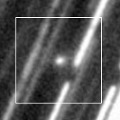
|
Now it is 16.8 mag (May 4, Martin Masek). It will be observable at 17 mag in good condition from April to May in the Southern Hemisphere. It is not observable after this in the Northern Hemisphere.
Date(TT) R.A. (2000) Decl. Delta r Elong. m1 Best Time(A, h)
May 14 20 22.55 -78 49.7 0.921 1.595 111 17.3 4:55 ( 0, 46)
May 21 21 35.90 -80 58.4 0.955 1.617 110 17.5 5:23 (359, 44)
|

|
It brightened up to 11-12 mag in 2012. It has already faded down to 16.2 mag (Mar. 28, Toshiyuki Takahashi). It is observable at 17 mag in good condition from winter to spring.
Date(TT) R.A. (2000) Decl. Delta r Elong. m1 Best Time(A, h)
May 14 10 22.27 -2 32.9 11.130 11.427 104 17.4 18:52 (180, 58)
May 21 10 21.38 -2 21.0 11.284 11.464 97 17.4 18:29 (178, 57)
|
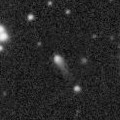
|
Now it is 17.1 mag (Apr. 8, D. Buczynski). It keeps 17.5 mag from 2016 to 2017. It is observable in good condition in the Northern Hemisphere. In the Southern Hemisphere, it locates low in 2016, and it is not observable in 2017.
Date(TT) R.A. (2000) Decl. Delta r Elong. m1 Best Time(A, h)
May 14 17 16.94 30 35.3 5.792 6.410 123 17.4 1:50 (180, 24)
May 21 17 13.14 31 38.0 5.769 6.399 124 17.4 1:18 (180, 23)
|

|
Now it is 19.3 mag (May 4, Hidetaka Sato). It will brighten up to 16.5 mag in summer and will be observable in good condition.
Date(TT) R.A. (2000) Decl. Delta r Elong. m1 Best Time(A, h)
May 14 18 21.24 -15 1.7 2.122 2.948 137 17.6 2:54 (180, 70)
May 21 18 19.23 -14 26.0 2.042 2.925 144 17.5 2:25 (180, 69)
|

|
Now it is 20.1 mag (Apr. 26, Jean-Francois Soulier). It is predicted to be observable at 17 mag from spring to autumn. But it is fainter than this ephemeris. It will be extremely low after summer in the Northern Hemisphere.
Date(TT) R.A. (2000) Decl. Delta r Elong. m1 Best Time(A, h)
May 14 14 29.81 -16 6.5 1.692 2.686 166 17.6 22:59 (180, 71)
May 21 14 23.81 -16 12.1 1.692 2.661 158 17.5 22:25 (180, 71)
|

|
It brightened up to 11.1 mag in 2015 autumn (Sept. 21, Seiichi Yoshida). Now it is 15.3 mag (Apr. 6, Thomas Lehmann). It keeps observable in good condition after this, while the comet will be fading gradually.
Date(TT) R.A. (2000) Decl. Delta r Elong. m1 Best Time(A, h)
May 14 11 13.57 11 45.9 2.483 3.000 111 17.6 19:44 (180, 43)
May 21 11 15.55 11 11.1 2.621 3.047 105 17.8 19:18 (180, 44)
|
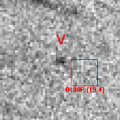
|
It is expected to brighten up to 16 mag and observable in good condition in autumn. However, it is so faint as 19.7 mag now (Apr. 16, A. Maury, J.-B. de Vanssay, J.-G. Bosch, J.-F. Soulier).
Date(TT) R.A. (2000) Decl. Delta r Elong. m1 Best Time(A, h)
May 14 22 41.09 -15 45.0 3.213 3.155 77 17.7 5:19 (240, 58)
May 21 22 47.94 -15 5.7 3.097 3.131 82 17.6 5:23 (231, 62)
|
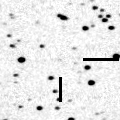
|
It was discovered around the aphelion in 2013 December. It keeps observable at 17 mag in good condition from 2016 to 2017. No observations have been reported since 2014 March.
Date(TT) R.A. (2000) Decl. Delta r Elong. m1 Best Time(A, h)
May 14 12 5.41 5 38.6 1.988 2.702 125 17.6 20:35 (180, 49)
May 21 12 3.99 5 19.6 2.033 2.668 118 17.7 20:06 (180, 50)
|

|
First return of a new periodic comet which brightened up to 16.5 mag in 2008. The condition of this apparition is very good. It is expected to brighten up to 15.5 mag in autumn and will be observable in good condition.
Date(TT) R.A. (2000) Decl. Delta r Elong. m1 Best Time(A, h)
May 14 23 23.41 -25 2.7 2.785 2.671 73 17.7 5:19 (264, 55)
May 21 23 32.95 -24 9.4 2.684 2.648 77 17.6 5:23 (259, 59)
|
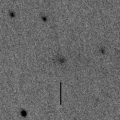
|
Now it is 16.8 mag (Apr. 12, Hidetaka Sato). It was expected to brighten up to 14 mag from winter to summer. But it is much fainter actually. It will be observable in excellent condition in the Southern Hemisphere. It locates low in the Northern Hemisphere.
Date(TT) R.A. (2000) Decl. Delta r Elong. m1 Best Time(A, h)
May 14 16 30.00 -39 4.0 1.656 2.608 155 17.7 1:03 ( 0, 86)
May 21 16 25.37 -39 35.4 1.677 2.648 159 17.8 0:31 ( 0, 85)
|
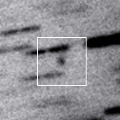
|
Now it is 18.0 mag (Apr. 12, A. Maury, J.-B. de Vanssay, J.-G. Bosch, J.-F. Soulier). It keeps observable at 17.5 mag in good condition from spring to autumn in the Southern Hemisphere. It is not observable in the Northern Hemisphere.
Date(TT) R.A. (2000) Decl. Delta r Elong. m1 Best Time(A, h)
May 14 18 18.03 -63 5.5 4.388 5.056 126 17.7 2:51 ( 0, 62)
May 21 18 15.81 -63 35.2 4.332 5.046 130 17.7 2:22 ( 0, 61)
|

|
Now it is 18.1 mag (Apr. 18, A. Diepvens). In the Northern Hemisphere, it keeps observable in good condition after this while the comet will be fading. It locates low in the Southern Hemisphere.
Date(TT) R.A. (2000) Decl. Delta r Elong. m1 Best Time(A, h)
May 14 13 12.03 28 22.9 2.802 3.460 123 17.7 21:41 (180, 27)
May 21 13 8.36 27 24.6 2.908 3.501 118 17.9 21:10 (180, 28)
|

|
Very far object. Outburst occured on Feb. 20, 2015, and it brightened up to 15 mag. Now it is 16.7 mag (Apr. 4, Hidetaka Sato). It is observable in excellent condition in the Southern Hemisphere. It locates somewhat low in the Northern Hemisphere.
Date(TT) R.A. (2000) Decl. Delta r Elong. m1 Best Time(A, h)
May 14 13 13.96 -24 8.3 8.298 9.181 149 17.7 21:43 (180, 79)
May 21 13 12.71 -23 48.3 8.355 9.184 143 17.7 21:15 (180, 79)
|

|
Although it was bright as 17 mag at the discovery in 2006, it faded out before the perihelion passage in 2008, and it became lost. Now it is fainter than 22 mag (June 15, 2015, Erwin Schwab, Marco Micheli).
Date(TT) R.A. (2000) Decl. Delta r Elong. m1 Best Time(A, h)
May 14 15 49.30 6 30.5 3.564 4.495 154 17.8 0:23 (180, 49)
May 21 15 45.29 6 36.7 3.562 4.488 153 17.8 23:47 (180, 48)
|
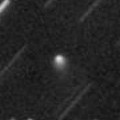
|
Now it is 17.4 mag (Apr. 15, H. Nohara). It becomes brighter than at the discovery in 2015. It is observable at 17.5 mag in good condition from spring to summer.
Date(TT) R.A. (2000) Decl. Delta r Elong. m1 Best Time(A, h)
May 14 14 55.68 3 29.4 5.523 6.464 156 17.8 23:25 (180, 51)
May 21 14 51.67 4 22.1 5.578 6.484 151 17.8 22:53 (180, 51)
|
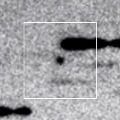
|
It keeps 16 mag for a long time from 2017 to 2018. Now it is 17.5 mag (Apr. 6, W. Hasubick). In the Southern Hemisphere, it keeps observable in good condition until early summer. It will be unobservable in May in the Northern Hemispehre.
Date(TT) R.A. (2000) Decl. Delta r Elong. m1 Best Time(A, h)
May 14 8 55.24 -21 1.8 6.627 6.707 90 17.9 18:33 (129, 70)
May 21 8 55.67 -19 58.5 6.698 6.677 84 17.9 18:29 (121, 65)
|
|
![]()
 116P/Wild 4
116P/Wild 4 29P/Schwassmann-Wachmann 1
29P/Schwassmann-Wachmann 1 118P/Shoemaker-Levy 4
118P/Shoemaker-Levy 4 53P/Van Biesbroeck
53P/Van Biesbroeck C/2011 KP36 ( Spacewatch )
C/2011 KP36 ( Spacewatch ) 104P/Kowal 2
104P/Kowal 2 77P/Longmore
77P/Longmore C/2015 T4 ( PanSTARRS )
C/2015 T4 ( PanSTARRS ) 146P/Shoemaker-LINEAR
146P/Shoemaker-LINEAR C/2015 TQ209 ( LINEAR )
C/2015 TQ209 ( LINEAR ) C/2015 V2 ( Johnson )
C/2015 V2 ( Johnson ) 333P/LINEAR
333P/LINEAR C/2014 W11 ( PanSTARRS )
C/2014 W11 ( PanSTARRS ) C/2013 V4 ( Catalina )
C/2013 V4 ( Catalina ) 65P/Gunn
65P/Gunn C/2014 Q2 ( Lovejoy )
C/2014 Q2 ( Lovejoy ) C/2015 ER61 ( PanSTARRS )
C/2015 ER61 ( PanSTARRS ) 100P/Hartley 1
100P/Hartley 1 C/2014 B1 ( Schwartz )
C/2014 B1 ( Schwartz ) C/2015 Y1 ( LINEAR )
C/2015 Y1 ( LINEAR ) C/2016 B1 ( NEOWISE )
C/2016 B1 ( NEOWISE ) C/2015 O1 ( PanSTARRS )
C/2015 O1 ( PanSTARRS ) C/2014 A4 ( SONEAR )
C/2014 A4 ( SONEAR ) C/2016 J2 ( Denneau )
C/2016 J2 ( Denneau ) C/2014 R3 ( PanSTARRS )
C/2014 R3 ( PanSTARRS ) C/2012 F3 ( PanSTARRS )
C/2012 F3 ( PanSTARRS ) 180P/NEAT
180P/NEAT C/2010 S1 ( LINEAR )
C/2010 S1 ( LINEAR ) C/2016 C2 ( NEOWISE )
C/2016 C2 ( NEOWISE ) C/2006 S3 ( LONEOS )
C/2006 S3 ( LONEOS ) C/2014 OE4 ( PanSTARRS )
C/2014 OE4 ( PanSTARRS ) 219P/LINEAR
219P/LINEAR 89P/Russell 2
89P/Russell 2 67P/Churyumov-Gerasimenko
67P/Churyumov-Gerasimenko 188P/LINEAR-Mueller
188P/LINEAR-Mueller P/2013 YG46 ( Spacewatch )
P/2013 YG46 ( Spacewatch ) P/2008 J3 ( McNaught )
P/2008 J3 ( McNaught ) C/2014 Y1 ( PanSTARRS )
C/2014 Y1 ( PanSTARRS ) C/2015 H2 ( PanSTARRS )
C/2015 H2 ( PanSTARRS ) 19P/Borrelly
19P/Borrelly C/2013 C2 ( Tenagra )
C/2013 C2 ( Tenagra ) P/2006 F1 ( Kowalski )
P/2006 F1 ( Kowalski ) C/2015 LC2 ( PanSTARRS )
C/2015 LC2 ( PanSTARRS ) C/2016 A1 ( PanSTARRS )
C/2016 A1 ( PanSTARRS )![]()















































